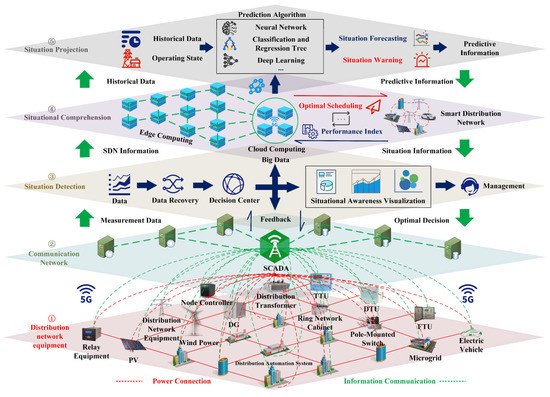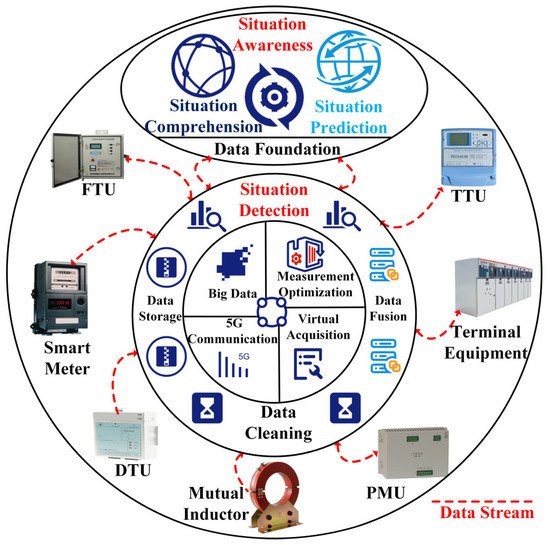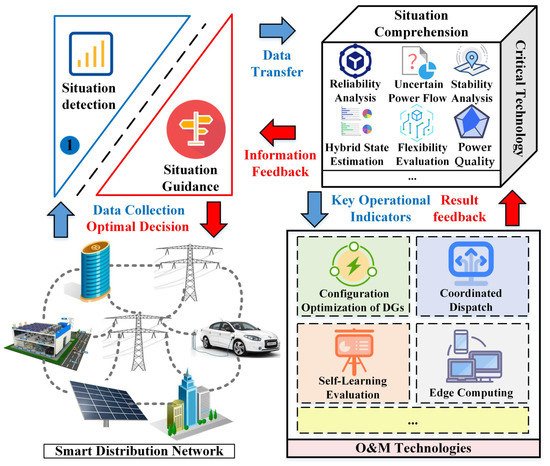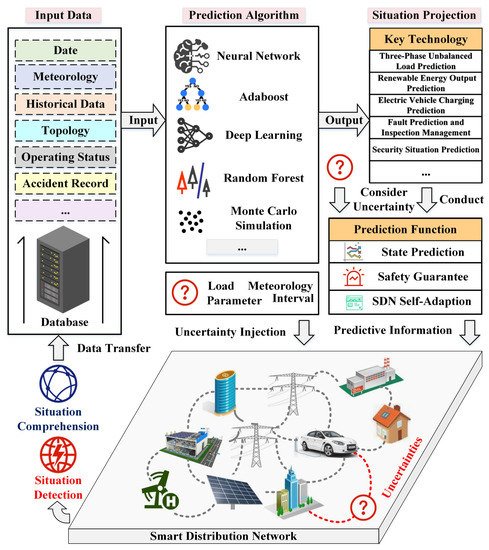Due to the rapid development of emerging information and communication technologies (ICT) and advanced metering infrastructure (AMI), distribution networks are in an evolvement from passive to active distribution networks (ADN), also called smart distribution networks (SDN). Operation and maintenance (O&M) cost is an economic factor that the SDN management must consider. Among multiple O&M technologies, situation awareness (SA) emerges and is gradually integrated into the SDN. Facing a high proportion of RES, adequate monitoring, analysis, and prediction of the SDN operating status are urgent. Therefore, comprehensive SA, which contains detection, comprehension, and projection, becomes a significant guarantee for the optimal operation of SDN.
- smart distribution network
- situation awareness
- high-quality operation and maintenance
- critical technology
- comprehensive framework
1. Introduction
- The sensation is the brain’s reflection of various attributes in objective things that directly act on the human sensory organs [14]. Human cognition of objective things starts with sensation. It is the initial detection of complex things and the basis of complex cognitive activities such as perception and behavior. That is similar to the concept of situation detection.
- Based on sensory information, perception processes multiple sensory information in a specific way, interprets the sensory information on individual experience, and taps the deep meaning of sensory information. That is similar to the concept of situation comprehension.
- Situational detection challenges. New measurement technologies such as AMI [
- Based on sensory and perception, behavior refers to human activities after receiving internal and external stimuli. The theory of planned behavior [15] can explain human decision-making behaviors from the perspective of perceptual information processing and predict the future behavioral tendency based on the expectation value theory [16]. That is similar to the concept of situation projection.
-
The sensation is the brain’s reflection of various attributes in objective things that directly act on the human sensory organs [14]. Human cognition of objective things starts with sensation. It is the initial detection of complex things and the basis of complex cognitive activities such as perception and behavior. That is similar to the concept of situation detection.
-
Based on sensory information, perception processes multiple sensory information in a specific way, interprets the sensory information on individual experience, and taps the deep meaning of sensory information. That is similar to the concept of situation comprehension.
-
Based on sensory and perception, behavior refers to human activities after receiving internal and external stimuli. The theory of planned behavior [15] can explain human decision-making behaviors from the perspective of perceptual information processing and predict the future behavioral tendency based on the expectation value theory [16]. That is similar to the concept of situation projection.
- Situation detection. The task of the stage is to detect essential features in the environment. Multi-dimensional data can be collected and completed in this stage. In addition, situation detection is the data basis of situation comprehension and projection.
- Situation comprehension. The essence of the stage is to understand the environment through data analysis. Specifically, the data obtained in the situation detection are integrated, and the connection and potential information between multi-source data are explored.
- Situation projection. The core of situation projection is to achieve the practical application of SA knowledge. Based on the information gained from situation detection and comprehension, this stage can predict the future environmental situation in time.
-
Situation detection. The task of the stage is to detect essential features in the environment. Multi-dimensional data can be collected and completed in this stage. In addition, situation detection is the data basis of situation comprehension and projection.
- 21]
- Situation comprehension. The essence of the stage is to understand the environment through data analysis. Specifically, the data obtained in the situation detection are integrated, and the connection and potential information between multi-source data are explored.
-
Situation projection. The core of situation projection is to achieve the practical application of SA knowledge. Based on the information gained from situation detection and comprehension, this stage can predict the future environmental situation in time.
2. Description of Situation Awareness for Smart Distribution Networks
2.1. Objectives of Situation Awareness for Smart Distribution Networks
- and phasor measurement units (PMUs)
- [
- 24]. The uncertain outputs of DGs and EVs lead to an imbalance between power supply and consumption. Although the SDN flexibility is improved, the RES outputs, three-phase unbalanced load, EV charging, inspection schedule, and stability margin are challenging to determine in the situation projection. Additionally, situation projection for complex scenarios requires sufficient mathematical analysis, computational capability, and robustness capability. How to effectively predict the operational trend of SDN needs to be solved urgently.
-
Situational detection challenges. New measurement technologies such as AMI [37] and phasor measurement units (PMUs) [38] are gradually deployed in SDN. Therefore, the data dimensions collected by SDN scale rapidly, which inevitably increases the computational pressure of SA. Due to the insufficient measurement devices, the collected data are challenging to recognize the poor operating status of the SDN. Therefore, the input data of the SA system are asymmetric, and some missing data are necessary to be accurately completed by calculation. How to comprehensively detect SDN status remains a challenging point in high-quality O&M.
- [22] are gradually deployed in SDN. Therefore, the data dimensions collected by SDN scale rapidly, which inevitably increases the computational pressure of SA. Due to the insufficient measurement devices, the collected data are challenging to recognize the poor operating status of the SDN. Therefore, the input data of the SA system are asymmetric, and some missing data are necessary to be accurately completed by calculation. How to comprehensively detect SDN status remains a challenging point in high-quality O&M.
- Situational comprehension challenges. Large-scale DGs lead the traditional dispatch mode to unsuitable. As a result, the phenomenon of reverse power transmission at the distribution network terminals is prominent, and the risk of voltage fluctuations and power loss increases
- [23]. In addition, different SDN topologies, operation modes, energy types, and automation levels have higher requirements for the compatibility of situational comprehension in different regions. Traditional situation comprehension technology is challenging to adapt to the current SDN. As the decision center of SDN, situation comprehension should assist the high-quality O&M of multi-form SDN. How to accurately understand the operating situation of the SDN is the focus of research.
-
Situational comprehension challenges. Large-scale DGs lead the traditional dispatch mode to unsuitable. As a result, the phenomenon of reverse power transmission at the distribution network terminals is prominent, and the risk of voltage fluctuations and power loss increases [39]. In addition, different SDN topologies, operation modes, energy types, and automation levels have higher requirements for the compatibility of situational comprehension in different regions. Traditional situation comprehension technology is challenging to adapt to the current SDN. As the decision center of SDN, situation comprehension should assist the high-quality O&M of multi-form SDN. How to accurately understand the operating situation of the SDN is the focus of research.
- Situation projection challenges. Unlike passive distribution networks, SDN has a higher proportion of DGs and electric vehicles (EVs) and more diverse operating modes
- The primary goal is to achieve real-time or quasi-real-time SA for SDN, which can accurately obtain the critical information of SDN, quickly determine the operating status of the distribution networks, and predict the development trend of SDN at the same time [11]. Based on the historical records of SDN data, SA provides a comprehensive SDN situation to ensure high-quality O&M.
- Observability is a significant technical indicator of SA. High-level SA can provide SDN with a highly visual situation and solve the shortcomings of insufficient measurement devices in the SDN [19].
- Through continuous innovation of intelligent algorithms, SA is cultivating SDN self-adaptive capabilities [20]. Based on the information obtained by SA, SDN can independently recognize and improve the situation in an informed way.
-
The primary goal is to achieve real-time or quasi-real-time SA for SDN, which can accurately obtain the critical information of SDN, quickly determine the operating status of the distribution networks, and predict the development trend of SDN at the same time [11]. Based on the historical records of SDN data, SA provides a comprehensive SDN situation to ensure high-quality O&M.
-
Observability is a significant technical indicator of SA. High-level SA can provide SDN with a highly visual situation and solve the shortcomings of insufficient measurement devices in the SDN [35].
-
SA has a significant contribution to SDN reliability. Specifically, conduct the SDN self-healing technology, detect potential SDN risks, and predict security situations in advance. Finally, a scientific basis for the SDN active defense can be provided [13].
-
Through continuous innovation of intelligent algorithms, SA is cultivating SDN self-adaptive capabilities [36]. Based on the information obtained by SA, SDN can independently recognize and improve the situation in an informed way.
2.2. Challenges of Situation Awareness for Smart Distribution Networks
- Situation projection challenges. Unlike passive distribution networks, SDN has a higher proportion of DGs and electric vehicles (EVs) and more diverse operating modes [
- 40]. The uncertain outputs of DGs and EVs lead to an imbalance between power supply and consumption. Although the SDN flexibility is improved, the RES outputs, three-phase unbalanced load, EV charging, inspection schedule, and stability margin are challenging to determine in the situation projection. Additionally, situation projection for complex scenarios requires sufficient mathematical analysis, computational capability, and robustness capability. How to effectively predict the operational trend of SDN needs to be solved urgently.
- ]
- .
- SA has a significant contribution to SDN reliability. Specifically, conduct the SDN self-healing technology, detect potential SDN risks, and predict security situations in advance. Finally, a scientific basis for the SDN active defense can be provided [13
3. Comprehensive Framework of Situation Awareness

4. Critical Technologies of Situation Detection

5. Critical Technologies of Situation Comprehension
Situation comprehension is the data analysis stage, which explores the potential information of the data collected in the situation detection. Many key operational performance indicators need to be correctly evaluated in SDN, such as reliability [31][65], flexibility [32][66], stability [33][67], and power quality [34][68], which are integrated into the analysis of the SDN situation. As the foundation of high-quality O&M, the implementation framework of situation comprehension is shown in Figure 3. First, SDN data are collected and completed by situation detection. Then, the data are transferred to the situation comprehension system to explore potential information. By conducting critical technologies of situation comprehension, many key operational performance indicators can be acquired and used as the data basis for O&M technologies. Then, the technologies contribute to high-quality O&M based on the situation comprehension results and return the calculation results to the situation guidance. Ultimately, the intelligent O&M combined with situation comprehension and management can be realized. The critical technologies of situation comprehension include uncertain power flow calculation, hybrid state estimation (HSE), reliability analysis, voltage stability analysis, flexibility evaluation, and power quality evaluation technology.
6. Critical Technologies of Situation Projection
Situation projection is the stage of state prediction to predict the SDN development, evaluate the operational risks, and provide predicted information for SDN management. With the intelligent O&M, the self-adaptation of SDN relies on accurate situation projection. The implementation framework of the situation projection is shown in Figure 4. First, a large amount of processed data from situation detection and situation comprehension is transferred to the situation projection system. Then, multiple factors such as meteorology, economy, society, resources, and load are comprehensively considered. In addition, state-of-the-art intelligent algorithms such as deep learning [39][105] and Adaboost [40][106] are applied to situation projection. Finally, critical technologies of situation projection are conducted to simulate and predict the SDN developing trend in different aspects. Meanwhile, the predicted information is sent back to SDN to provide theoretical support for optimal decision making. The critical technologies of situation projection include three-phase unbalanced load prediction technology, renewable energy output prediction technology considering uncertainty, state-of-energy estimation technology, fault prediction and inspection management technology, and security situation projection technology.
